Lesson Plan - Teach North Texas
advertisement
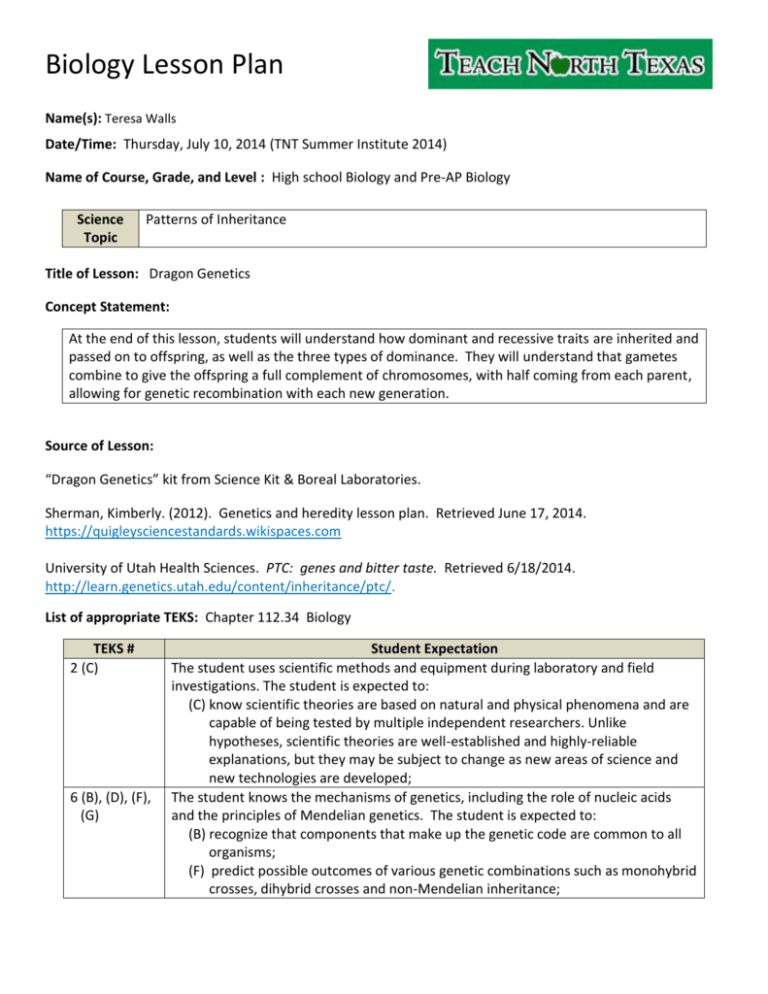
Biology Lesson Plan Name(s): Teresa Walls Date/Time: Thursday, July 10, 2014 (TNT Summer Institute 2014) Name of Course, Grade, and Level : High school Biology and Pre-AP Biology Science Topic Patterns of Inheritance Title of Lesson: Dragon Genetics Concept Statement: At the end of this lesson, students will understand how dominant and recessive traits are inherited and passed on to offspring, as well as the three types of dominance. They will understand that gametes combine to give the offspring a full complement of chromosomes, with half coming from each parent, allowing for genetic recombination with each new generation. Source of Lesson: “Dragon Genetics” kit from Science Kit & Boreal Laboratories. Sherman, Kimberly. (2012). Genetics and heredity lesson plan. Retrieved June 17, 2014. https://quigleysciencestandards.wikispaces.com University of Utah Health Sciences. PTC: genes and bitter taste. Retrieved 6/18/2014. http://learn.genetics.utah.edu/content/inheritance/ptc/. List of appropriate TEKS: Chapter 112.34 Biology TEKS # 2 (C) 6 (B), (D), (F), (G) Student Expectation The student uses scientific methods and equipment during laboratory and field investigations. The student is expected to: (C) know scientific theories are based on natural and physical phenomena and are capable of being tested by multiple independent researchers. Unlike hypotheses, scientific theories are well-established and highly-reliable explanations, but they may be subject to change as new areas of science and new technologies are developed; The student knows the mechanisms of genetics, including the role of nucleic acids and the principles of Mendelian genetics. The student is expected to: (B) recognize that components that make up the genetic code are common to all organisms; (F) predict possible outcomes of various genetic combinations such as monohybrid crosses, dihybrid crosses and non-Mendelian inheritance; Objectives Write objectives in IWBAT form. 1 2 3 4 Evaluation Questions (at least one open-ended) Each question should match the written objective. You may use one of your sample TAKS/STAAR problems as a guiding template for your evaluation questions. Note: these should be the SAME questions you are utilizing in the evaluation section. Include answers to all questions. Include 1 real-world, 1 griddable, and 1 explanation question “I will be able to explain the difference between a dominant and recessive trait.” “I will be able to predict the outcome of a monohybrid cross between two individual organisms.” How does a dominant trait differ from a recessive trait? “I will be able to differentiate between genotype and phenotype and give examples of each. “I will be able to list the three types of dominance and give an example of each type.” Explain the difference between “genotype” and “phenotype" In cocker spaniels the allele for a black coat color (B) is dominant over the allele for a brown coat color (b). If a brown cocker spaniel is crossed with a heterozygous black cocker spaniel, which of the following genotypic ratios can be expected? F 0 BB: 2 Bb: 2 bb G 1 BB: 2 Bb: 1 bb H 2 BB: 0 Bb: 2 bb J 2 BB: 1 Bb: 0 bb List the three types of genetic dominance and give an example for each type. Resources, Materials, Handouts, and Equipment List in table format: ITEM Quantity Source (Specify worksheets) (How many do you need?) (Who is responsible? (teacher, student, group) List who this is for Dragon Genetics kit from Ward’s 1 (class set of 16, designed for Teacher Science students to work in pairs) https://wardsci.com/store/catalo g/product.jsp?catalog_number=3 66295 Students and teacher Poster-sized Post-It® paper 1 tablet Teacher Students and teacher Supply box for each table containing scissors, Post-It® notes, map pencils and Sharpies. 1 per table Teacher Students Paper towels two towels per group Teacher Students Teacher Students Vocabulary cards to laminate and 1 set put on board as terms are introduced Advanced Preparations: (1) The Dragon Genetics kit requires some preparation by the teacher before class begins. There is a packet that comes with the kit that has instructions as well as blackline masters. Read through the packet to familiarize yourself with the activities. Instructions on how to set up the kit can be found on page 4 of the packet. (2) Make copies of activity sheets. (3) A box of student supplies per group. PowerPoint (Embed as Object here): (Be sure the PPT includes all components outlined on the rubric) 5E Lesson Plan Objective Statement: At the end of this lesson, students will be able to explain how dominant and recessive traits are passed from parent to offspring. ENGAGEMENT What the Teacher Will Do A pre-test for this content was given on the previous day. The teacher will ask each student to get 2 Post-It® notes from the supply box on the table. Ask the students to: (1) clasp their hands together and observe which thumb is on top, the right or the left. The students will write this information on their Post-It® note. (2) write down if they are right-handed or lefthanded on the second Post-It® note . (3) The students will then be asked to stick these notes on a designated chart at the front of Time : 5 Minutes Probing/Eliciting Questions and Students Responses What the Students Will Do Each student will get a Post-It note and answer each question on a separate note. the room. This chart will be divided into segments that correspond with the possible answers that students might have. Take a moment to let the students look at the posters. 1. 1. “Look at the Post-It® notes on the poster. What do you notice?” 2. “These characteristics that we just looked at can also be called traits. Look at the class results on our posters. Based on our class results when looking at our posters, which do you think is most common, right thumb-over-left or left thumb-over-right? Why?” 3. “What about right- or lefthandedness? What do you think the pattern of inheritance is for this trait?” 4. “What determines the traits that we inherit? “ 2. Students should notice that on the “Thumb” poster that more people indicated that they were right-handed than lefthanded. For handclasping, there should be more left-over-right individuals than right-overleft. (These patterns SHOULD be observed in a classroom of typical size.) [Left thumb-over-right is dominant, with right thumbover-left being recessive. ] Why? [Because there are leftover-rights in our class.] 3. [Right-handedness is more common.] 4. [DNA] [genes] [our parents] Transition Statement ‘Let’s take a look at some other traits and explore how these traits are inherited.” EXPLORATION What the Teacher Will Do Pass out handout entitled “Dragon Genetics Worksheet #3A: “Do Your Ears Hang Low?” Have a student read the instructions for this activity aloud. “You are going to be working with your shoulder partner for this activity. Look at the list of ten traits listed on the left side of this handout. Read the description of each one and determine if you have or do not have the trait as it is described. In the first column on the handout, labeled “Activity 3A”, write down if you have the dominant or recessive form for each trait. Do not fill in the second column at this time.” Explain what Darwin’s ear point is before starting the activity, as most students will be unfamiliar with the term. “Before we start, I will give everyone a piece of SBT paper and a paper towel. To taste it, get some saliva in your mouth and place the paper on your tongue.” (demonstrate this Time: 20 Minutes Probing/Eliciting Questions and Student Responses What the Students Will Do Students will put their name on the handout and follow along as the directions are read aloud. for the students). “Dispose of the SBT paper on the paper towel on your desk when you are finished.” Working with a shoulder partner, students will look at each trait listed on the handout and determine if they are dominant or recessive for the trait. This information will be noted on the handout. “Continue down the list on the handout. Once you and your partner finish the activity, go to the class chart and put a tic mark in the proper column for each trait. We’ll look at class results when everyone is finished. You will have 10 minutes to complete this part of the activity.” Once each pair finishes, they will go to the class chart and note which form of the trait they have. Teacher will walk around the room and monitor as the students work, clarifying any questions they may have. “Let’s look at our results. Did everyone get their data on the chart?” Go through the list, clarifying what each trait looks like and asking students who have these traits to show them to the class. “Can someone tell me what the term “dominant” means in genetics?” [It’s the version of a trait that shows.] [It’s the strongest form of a trait.] [If a person has a dominant gene for a trait, it’s the form that will show up.] “What is a recessive trait?” [It’s the weaker form of a trait.] [It will show up if the person has a recessive gene.] [It will only show up if all of a person’s genes for that trait are the recessive form.] “How many of you tasted something when you put the SBT paper on your tongue?” (Ask for a show of hands). “What did it taste like?” Answers will vary. Since this is a dominant trait, more students should be tasters than non-tasters. The SBT paper tastes bitter to those can taste it. “Why do you think being able to taste or not taste some things is inherited? [Maybe it has something to do with How might this work?” body chemistry.] [Non-tasters are missing a chemical receptor that would allow them to taste this compound.] “Polydactyly is actually a dominant trait, yet most of us in the room do not have this trait. Why would most members of a population exhibit the recessive form of a trait?” [Dominant form of trait doesn’t have to be the most common; people in a particular area may exhibit recessive form, i.e. blueeyed Scandinavians.] (Frequency of polydactyly in the U.S. is 1 per 500 to 1000 births. There may some students in the room who are dominant for polydactyly. In the United States, extra digits are generally removed when a person is very young.) “We’ve taken a look at some common dominant and recessive traits. The physical expression of a trait is known as its phenotype. Transition Statement “Let’s take a look at how these traits can be represented.” EXPLANATION What the Teacher Will Do The teacher will distribute a copy of two handouts: “Dragon Genetics Worksheet #1: “I’m All Keyed Up” and “Dragon Genetics Worksheet #2: “Would Someone Please Take Charge?’ Instruct students to complete the questions on “I’m All Keyed Up” (about 8 minutes). Time: 30 Minutes Probing/Eliciting Questions and Student Responses What the Students Will Do Students will put their name on the handout and follow along as the directions are read aloud. Students will work on this individually. “The Dragon Key gives us a list of traits that are dominant and recessive in dragons. How are the dominant genes represented?” “How are the recessive alleles represented?” “What are some of the dominant traits from this list? “For our study of Dragon Genetics, we are going to look at traits that are controlled by only two alleles. This kind of trait results from a monohybrid cross”. [Dominant alleles are represented by a capital letter.] [Recessive alleles are represented by the same letter, but in smallcase.] [long neck, horn present, green body, spikes on end of tail, three toes, black tail spikes, red eye, firebreathing, long tail, red wings, yellow belly, freckles] “What are some of the recessive traits from the list?” [short neck, no horn, gray body, no tail spikes, four toes, red tail spikes, white eyes, non-fire breathing, short tail, yellow wings, white belly, no freckles] “How do we inherit our alleles?” [From our parents]. “What does “mono’” mean? [mono- = “one”] “Not all traits are as cut-and-dried as the ones we’re going to look at here. While some traits are determined by only two alleles (1 set), others are determined by a number of alleles. Can you think of any traits that are probably controlled by many genes (alleles)?” [Hair color, eye color, skin color]. “Why do you think hair and eye color inheritance might be more complex?” [Because there are many different eye colors and hair colors, not just light and dark.] “If inheritance as the result of only two alleles (1 set of genes) is called a monohybrid cross, what would a trait that is controlled by many pairs of alleles be called?” [multihybrid] “Look at the last trait on the list. In the case of ear frills, the sex of the dragon determines whether it will have ear frills or not. If the dragon is male, what will its phenotype for ear frills be?” [Males will all have ear frills.] [polygenic] “What about the females? What will their phenotype for ear frills be?” [All of the females will not have ear frills.] “Take a look at the handout entitled “#2: Would Someone Please Take Charge?” Students will put their names on Dragon Genetics Worksheet #2: “Would Someone Please Take Charge?” Call on a student to read the instructions aloud. “Let’s look at the alleles that determine neck size. “If having a long neck is dominant, what allele must be present in order for a dragon to have a long neck?” [At least one dominant gene must be present for a dragon to have a long neck.] “How is a dominant allele represented?” [With a capital letter.] “What if a dragon has one dominant allele and one recessive allele for a trait? What will it look like?” [If a dragon has one dominant and one recessive allele, it will show the dominant form of the trait.] “What is the genetics term for the appearance of an organism?” “There are two other vocabulary terms that you need to be familiar with as we talk about inheritance. If an individual has two alleles that are identical, like NN or nn, that gene pair is described as homozygous. If an individual has a pair of alleles with one dominant trait and one recessive trait, they are described as heterozygous. If the organism has two dominant alleles, they are homozygous dominant “So, we know that a long-necked dragon can have two dominant alleles (NN) or one dominant allele and one recessive allele (Nn). What term is used for the actual alleles that determine the trait, like NN or Nn.” [Phenotype] [Genotype] “If the individual has two recessive alleles, they are described as _____.” [homozygous recessive] “With your shoulder partner, take 5 minutes to complete the table. “ At the end of 5 minutes, have students share their answers. “To wrap up this part of the lesson, let’s go back to Handout #3A: “Do Your Ears Hang Low? Look at the last column.” Put a copy of Worksheet #4: “Enter the Dragon” on the document camera and complete the second column together as a large group. Ask individual students to share out answers. “Traits are encoded on cell structures called chromosomes. Half of your chromosomes come from your mother’s egg and half come from your father’s sperm.” “If humans have 46 autosomal (body) chromosomes, how many of those are contributed from the mother? How many from the father?” [Mom = 23, Dad = 23} “Why do egg and sperm cells have only half as many chromosomes as body cells?” “What kind of cell division allows for the creation of body (autosomal) cells? “What kind of cell division allows for the creation of sex cells (= allosomes or gametes)? “So, we’ve said that humans have a chromosome number of 46. They also have a pair of sex chromosomes that determine gender. “Which parent determines the sex of a baby?’ “Does anyone know why?” “What is the genotype of a female?” [Because humans can only have 46 chromosomes under normal conditions. 23 from Mom and 23 from Dad allow the offspring to inherit traits from both parents and have a total chromosome number of 46.] [mitosis- creates daughter cell just like the original] [meiosis- creates sex cells with a haploid (half) complement of chromosomes.] [The father.] [Because the father has two different types of sperm. Half carry a female gamete [X} and the other half carry a male gamete [Y]. “What is the genotype of a male?” [XX] “So if each parent contributes one of their sex chromosomes, which parent determines the sex of the offspring?” “To correctly write the genotype of a human, one would write the female genotype as “46XX”, because humans have 46 chromosomes and the XX says that this individual is female.” Show the students a basic Punnett Square showing the probability of having a male or female child. “How would we write the genotype of a human male?” “So, we know that Dad determines the sex of the baby. What is the probability of having a male or female child?” [XY] [The father, because he can contribute either an X or a Y chromosome. Mom can only contribute X chromosomes.] [46XY] [50/50] “If we put the genotypes of Mom and Dad in a Punnett Square, you can see that there is a 50/50 chance of having a boy or a girl.” X X X XX XX Y XY XY “Let’s look at a pair of dragon chromosomes. Look at the handout entitled “Dragon Genetics Worksheet #4: “Enter the Dragon”.’ “You’ll notice that each dragon chromosome carries alleles for three traits. Let’s look at the alleles that the baby dragon from these two parents will possess.” (Complete the table together). Trait Genotype Phenotype Fire breathing Ff Fire breathing Body color Gg Green body Spikes present or Ss Spikes not present Transition Statement “Now let’s take this information a step further. Yyou and your partner get to be the proud parents of a bouncing baby dragon! ELABORATION What the Teacher Will Do Time: 40 Minutes Probing/Eliciting Questions and Student Responses Pass out the following materials per pair of students: Students will put their name on Worksheet #5. Dragon Genetics Worksheet #5 One set of Dragon eggs containing the chromosomes for each parent. One Dragon Blackline Master 1 piece of card stock Supply box containing map pencils, glue sticks, scissors, Sharpies and tape. “One member of each group will be a Dragon Daddy and the other member will be a Dragon Mama. Your eggs are marked as being male or female. Take a moment to sort out your “sex cells” into male and female sets. “As dragon parents, you will contribute alleles for several traits to your baby, as well as an X or a Y chromosome to determine the baby’s sex.” What the Students Will Do “What is another name for sex cells?” [Allosomes] [gametes] “What does it mean if an organism is homozygous for a trait?” “What does it mean if an organism is heterozygous for a trait?” [Two alleles that are identical for a trait, such as AA or aa.] [The offspring has one dominant and one recessive allele for the trait.] [The baby will display the dominant form of the trait.] “What will the phenotype be for an individual who has a heterozygous genotype?” “Each egg or sperm will contain alleles for several traits. Open the containers to determine what alleles your baby will inherit. Use the data table on “Dragon Genetics Worksheet #5” to record the genotype for each trait. You will tell if your offspring is homozygous or heterozygous for each trait and then write down the baby’s phenotype for each pair of alleles.” “Once you’ve determined the genotype of your baby for each trait, use the dragon parts on the “Dragon Blackline Master” to build your baby. Cut out the parts that fit the phenotype of your dragon and build your dragon on the piece of cardstock that has been provided. You may use either a glue stick or tape. Color your dragon the appropriate colors and label your dragon to identify which traits it has inherited and the genotype for that trait.” (Have a work sample available to model how students should label their dragon.) “You will have 35 minutes to Students will build their dragons. work.” (The teacher will walk around the classroom and monitor the students as they work.) Students will share their baby dragon with the class. Once the students have completed the assignment, have them share their dragons with the class. “With these activities, we’ve taken a look at one type of dominance. This type of dominance, in which one gene completely masks another gene, is called complete dominance. There are two other types that we’ll look at briefly.” “The second type of dominance is called incomplete dominance. With this pattern of inheritance, there is a dominant phenotype, a recessive phenotype and a third phenotype that is between the dominant and recessive forms. An example of this is shown with a flower called a 4o’clock.” R R r Rr Rr r Rr Rr RR = red flowers rr = white flowers Rr = pink flowers This same pattern holds true for human hair texture. “With hair texture, an individual with a genotype of CC has curly hair. An individual with a genotype of cc has straight hair and a heterozygous individual (Cc)has wavy hair. Is it possible for two wavy-haired individuals to have a child with C c C CC Cc c Cc cc “The third type of dominance is called codominance. In this type of dominance, two types of genes can act as dominants and both be expressed.” straight hair? Draw the Punnett Square to demonstrate your answer.” “There are four human blood types, A, B, O and AB. A is dominant over O. B is dominant over O. A and B are codominants. A O B AB BO O AO OO The O allele will always be overshadowed by either A or B. A type O individual has the recessive form of this trait. “Look at this Punnett Square. An individual who is heterozygous for Type A has a child with an individual who is heterozygous for Type B. What is the probability that these two heterozygous parents will have a child with Type O blood?” “Draw a Punnett Square for a parent who has Type AB blood and a parent who is heterozygous for Type B.” What is the probability of these parents having a baby with Type A blood? A baby with Type B blood? [25%] A B B AB BB O AO BO [25%] [50%] [0%] A baby with Type O blood? Transition Statement “Thank you, dragon parents, for sharing your babies with us today. “ Closure Statement “During the course of this lesson (Dragon Genetics), we’ve looked at dominant and recessive traits, the three types of dominance and discussed how offspring inherit half of their genetic information from their mother and half from their father, with the offspring ‘s genotype being different from that of either parent. EVALUATION What the Teacher Will Do The teacher will allow 5 minutes for the post-test. The teacher will monitor the room as the students complete the post-test, answering questions as necessary. Go over the answers when everyone is finished. Collect the post-test documents. Time: 10 Minutes Probing/Eliciting Questions What the Students Will Do Students will clear their desks for the final evaluation. The students will complete a posttest.
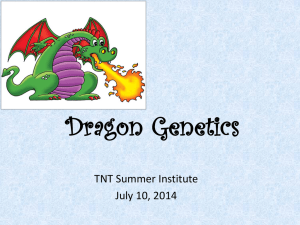
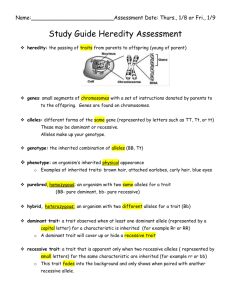


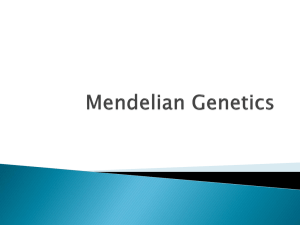
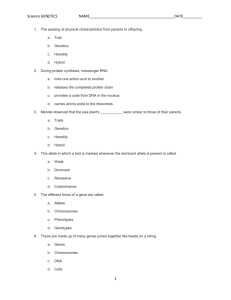
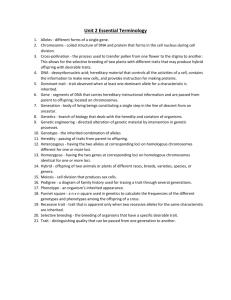
![Biology Chapter 3 Study Guide Heredity [12/10/2015]](http://s3.studylib.net/store/data/006638861_1-0d9e410b8030ad1b7ef4ddd4e479e8f1-300x300.png)

